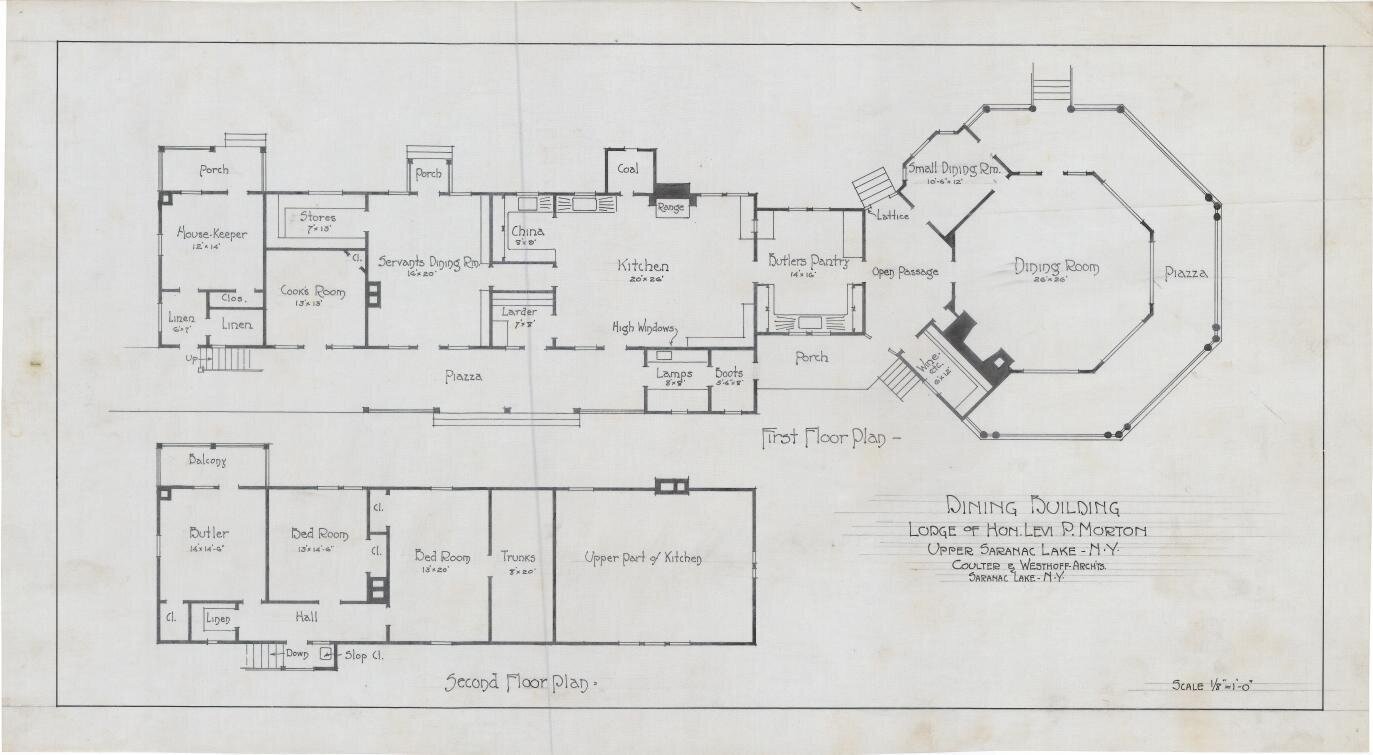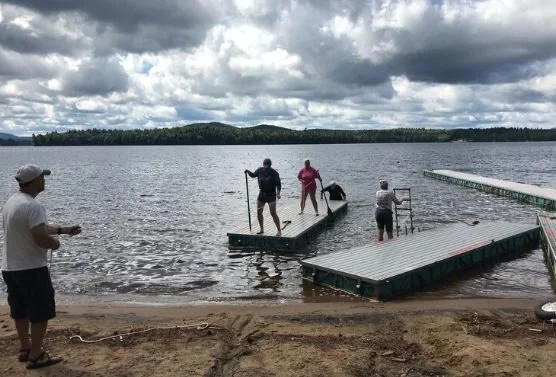
Adirondack Great Camp
Eagle Island Camp
built in 1903
1800’s
The Adirondacks became a popular summer retreat destination, thanks in part to William H. H. Murray, who published Adventures in the Wilderness; Or Camp-Life in the Adirondacks in 1869, and later became known as the father of the Outdoor Movement.
-
Programming focused on swimming, canoeing, hiking, sailing, and outdoor skills. Younger girls did overnights to camping spots up and down Upper Saranac, and took day hikes, including climbing Mt. Ampersand, which can be seen from Eagle Island. Older girls often took advantage of the many available destinations in the Adirondacks for multi-day canoeing and backpacking trips. The sailboats at Eagle Island were constantly in use on any windy day. Girls learned basic sailing and also practiced racing tactics as their skills improved. Alumnae credit these camp experiences as key to developing the resilience, independence, and strong leadership skills that have served them well through their lives.
A typical day at Eagle Island Camp began with flag ceremony and a hearty breakfast in the Dining Hall. Daily activities included swimming, boating, arts & crafts, campcraft, cookouts, and occasional off-island excursions. Each meal concluded with singing. The first night of every 2-week session was an all-camp campfire in the Lodge, and the staff would be introduced through humorous lyrics sung to popular tunes. There was a costume closet full of donated clothing and dresses from a variety of eras that were used for skits throughout the summer. All-camp activities always ended with the songs Green Trees, Peace, and Taps.
Depending upon the decade, camp alumni remember 4th of July barbecues, sleeping on the Boathouse porch, the highly competitive Song Contest during session 2, folk dancing in the Lodge, making ice cream from scratch, dance parties, Yon Far Beacon Regatta, and Rededication. Also, chilly early morning swims, practicing canoe portaging across the island, sailing far and wide up and down the lake, Church Isle Sundays, climbing Mt. Ampersand, cooking s'mores around a campfire, and much more.
Outside of the youth camping season, Eagle Island hosted an annual Women's Weekend and Family Camping weeks. Eagle Island also periodically welcomed Scout groups on multi-day canoe trips to stop overnight and camp out on Mariner's Rock.
Eagle Island, Inc. has many treasures from the Girl Scout Era, you can look through these here!
1903
The camp was designed in 1903 by William Coulter, who is considered a prominent Adirondack architect. Coulter studied at the Cooper Institute (which became the Cooper Union) and worked for the architectural firm Renwick, Aspinwall and Renwick, the office of the nationally prominent architect James Renwick.
-
Examples of Coulter’s work include Knollwood Club, Prospect Point Camp, and a house in Saranac Lake called “The Porcupine,” built for Thomas Bailey Aldrich, editor of The Atlantic Monthly. For Eagle Island, Coulter worked with his new partner, Max Westhoff, and the contractors Trombley & Carrier. Eagle Island Camp is considered a quintessential and highly intact example of an Adirondack Great Camp and the finest example of Coulter’s work. For a fascinating article on Eagle Island and the historical context in which it was constructed, see this 2016 Curbed.com article.
As stated in the NHL nomination, “Eagle Island is arguably Coulter's finest extant rustic camp with design integrity to the original construction period. Evident in the design of Eagle Island Camp are the distinctive elements that formed Coulter's unique interpretation of the Adirondack camp. The use of both chalet-inspired and octagonal units, walkways and verandahs linking separate buildings, and the extensive application of open rustic screening are all characteristic of Coulter's work and essential to the success of his Eagle Island scheme. Eagle Island Camp retains the majority of its character-defining features and exterior and interior historic fabric and finishes, and remains an outstanding representation of Coulter's work in the rustic vein.”
Eagle Island is also associated with significant people in the nation’s history. The camp was commissioned by Levi P. Morton, who served as U.S. Vice President from 1889-1893 under Benjamin Harrison, as Governor of New York from 1895-1896, as ambassador to France, and for two congressional terms representing the district of Manhattan. Prior to Eagle Island, Coulter had worked for Morton on modifications to Camp Pinebrook, also on Upper Saranac Lake.
1910
Henry Graves, Jr., a wealthy banker and industrialist from Orange, New Jersey, purchased the property from the Mortons. Graves is known for competing with auto manufacturer James Packard for ownership of the world’s most complicated watch. Graves eventually beat Packard by commissioning the Patek Philippe Henry Graves Supercomplication watch in 1933. In 2014, the Supercomplication set a new record price for a timepiece sold at auction.
1937
The Graves family gifted Eagle Island to the Girl Scouts of Maplewood and the Oranges in 1937.
1970’s
In the mid-1970s, with the realization that these properties were vulnerable, and overlapping with the nationwide historic preservation movement, efforts were made to preserve and protect these camps. Camp Sagamore was the first focus and was the impetus for an extensive survey of properties in the region that might qualify as Great Camps.
1986
A multiple property nomination was accepted to the National Register of Historic Places including ten camps. Since then, five of these have become National Historic Landmarks, including Eagle Island.
-
Eagle Island Camp is listed as an NHL under criterion 4, for exhibiting “properties that embody the distinguishing characteristics of an architectural type specimen exceptionally valuable for a study of a period, style, or method of construction, or that represent a significant, distinctive and exceptional entity whose components may lack individual distinction.”
Although it is not part of the “period of significance” of the NHL, the presence of the Girl Scout camp on the island is also an important part of Eagle Island’s history, as it speaks to the development of the youth summer camp movement in the United States, which also traces its roots in part to William H.H. Murray’s Outdoor Movement and the Adirondacks. In Abigail Van Slyck’s award-winning book, A Manufactured Wilderness: Summer Camps and the Shaping of American Youth, 1890-1960, she analyzes the history and development of youth summer camps and makes a compelling argument for their consideration as important cultural landscapes.
Eagle Island is significant in that it embodies all of these stories: an Adirondack Great Camp and summer retreat for prominent American families, an early Girl Scout summer camp, and now, a contemporary youth summer camp.
1938-2008
In 1938 the Girl Scouts of the Oranges and Maplewood, New Jersey, opened Eagle Island as an overnight camp. Generations of campers, living in platform tents, enjoyed the island for 70 years until the camp closed in 2008.
-
The region began to be developed, and the wealthy elite built what became known as “Great Camps,” expansive family compounds in the “Adirondack rustic” style, inspired by the British Arts and Crafts Movement and the American Craftsman style. They were the equivalent of Gilded Age mansions in the wilderness.
2011
Eagle Island, Inc. (formerly known as Friends of Eagle Island, Inc.) was formed in 2011 as a nonprofit corporation with the mission of preserving this unique summer camp and historic landmark. This group of alumni and friends spanned all the decades of camp operation, including campers from the 1930s through the 2000s. Staff, campers, family campers, neighbors and more joined together to work toward re-opening Eagle Island for future generations.
2015
In November 2015, Friends of Eagle Island, Inc. acquired Eagle Island through an extraordinary donation. This purchase completed the first phase of EIC’s vision of ensuring that “children may always play” on Eagle Island.
-
Following the acquisition, EIC immediately began planning and fundraising. Professional assessments of the island’s historic structures and systems were obtained, while funding and grant committees were formed to reach out to supporters and foundations. Despite the lack of running water, MANY supporters volunteered on the island during the summers of 2016–2019. They undertook clean-up, painting, carpentry, and other repairs.
The extensive building stabilization and rehabilitation, and water, septic, and electrical upgrades required professional contractors. In addition, camp operations would require a Department of Health-certified kitchen and health center.
2016
EIC received a grant from the New York Regional Economic Development Council for the first phase of critical historic preservation and rehabilitation of the National Historic Landmark buildings and structures. Other smaller grants have been received, including four from the Cloudsplitter Foundation in Saranac Lake.
-
Major construction work began in the spring of 2016. The non-historic preservation work has been funded primarily by contributions from EI’s growing list of supporters. During the summer of 2019, EI was able to operate two weeks of all-gender day camp, despite the lack of running water. The Main Camp area was upgraded and ready for overnight campers in 2020, including the camp kitchen, health center (former infirmary), running water, ample electrical supply, and working Green Johns. Unfortunately due to COVID-19, all programming was suspended.
2019
The island welcomes back campers for the first time in over a decade!
TODAY
EIC is growing, expanding, and strengthening our programming and purpose, developing new ways to fulfill our mission in a women-led environment. EIC offers youth camp, womens weekend, and special retreats.
-
The reopening of Eagle Island as a youth camp offers a unique opportunity for children to live, learn, and play in a historic Great Camp setting while at the same time providing a way to preserve and maintain the integrity of the historic resource.
In 2024 EIC expanded its capacity with the opening of the Adirondack/Islanders tent site. We now have the capacity to welcome up to 84 campers per week!
By 2027, we will accommodate up to 132 campers/week with the revitalization of our 3rd and final camp site, Lakeside.
Great Camp Buildings
These incredible structures not only survive today but are utilized as housing, office, dining, kitchen and program spaces for today’s campers.




























